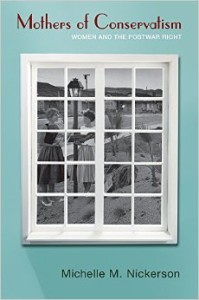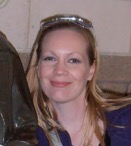Michelle M Nickerson, Mothers of Conservatism: Women and the Postwar Right
(Princeton: Princeton University Press, 2014) 264 pages.
Review by Kristen Shedd
In Mothers of Conservatism, Michelle Nickerson presents an absorbing examination of grassroots political organization by women in the greater Los Angeles area, from the mid-1940s to the early 1960s. Michael Kazin, in the 1990s, showed us that populism was not just a movement of the left, but also a political style just as useful and effective for conservatives, especially after World War II. In populist language, conservatives found a tool for challenging the state, as well as an academic professional elite, they perceived as bent on undermining the nation’s morals and traditional values. With a thoughtful and considered analysis of what she calls “housewife populism,” Nickerson demonstrates the significance of grassroots women in shaping modern conservatism, helping to explain the rise of the postwar political right.
Elaborating on Lisa McGirr’s study of women in Orange County, Nickerson explores the role of suburban women throughout an L.A. region connected by a highway system, which linked growing suburbs to one another, as well as to the city. Housewives used their unique class status, which allowed them the time to be politically active, to put together newsletters, join the John Birch Society, engage in letter writing campaigns, and to open “’patriotic’ bookstores in their neighborhoods that featured their favorite conservative authors” (xxiii). Fears of a leftist enemy required constant vigilance. Perhaps, most importantly, middle class housewives, unlike their husbands, had time to study communism, a necessity because of the perception by these “activists that leftists were getting dirtier and sneakier” (71).
To be effective and to justify their political action, these housewives embraced traditionally defined feminine values of vigilance, selflessness, and spirituality. Further, as these women added an anti-expert, local home-rule, to traditional conservative anti-statism, their identity as housewives gave them an insider legitimacy, presenting their cause as one of common sense, as “ordinary folks” attacked by an outside elitist enemy. Most of these grassroots activists, though middle-class and wealthy, united as homemakers who felt 
besieged by experts intruding on the home, their authority as mothers, and their personal knowledge of community well-being.
Nickerson traces the origins of a feminized anti-state activism back to the 1920s, and in particular, the anti-communism of the 1930s. Elizabeth Dillinger, of The Red Network fame, often relied on outlandish tactics and constructed an image of a victimized middle-class patriot. Gerald L.K. Smith, with Christian Nationalist Crusade, used mothers’ authority as a justification for his causes of isolationism and anti-communism. Anti-Semitism, an important element in the 1930s would fade, reappearing occasionally, but the drive to resist an incorporated anathema of internationalism, communism, and racial integration defined conservative post-war action, and transformed it from a class-based critique to one focused on educators, experts, and public health professionals.
After World War II, housewives quickly organized to stop the distribution of United Nations Educational, Scientific, and Cultural Organization (UNESCO) materials in the public schools. Two pamphlets raised special concern because this grassroots network believed they presented the U.N. and internationalism too positively, while at the same time the pamphlets warned of the dangers of nationalism. Here, Nickerson shows just how important public schools became in the struggle to maintain local control, parental authority, and in establishing an insider-outsider understanding of power. By 1951, L.A. schools banned UNESCO literature, a success in the drive against progressive education, which conservative activists associated with social reform and manipulation of children. These housewives, as opposed to internationalist progressive educators, believed new teaching methods fostered lazy minds susceptible to communism. A common theme, among the women’s oral histories is an awakening, a moment when they believe they have become aware of the danger of communism, and involvement in these educational campaigns often provided that epiphany.
California mental health bills in 1955, and Alaska’s attempts to fund psychiatric facilities in its own territory, raised fears among conservative housewives about the power of mental health and government officials. The mental health movement stood as a threat as well, because social scientists and political historians often saw the American right as paranoid and abnormal. Racism and extreme political ideologies were defined as adverse to mental health, and housewives noted the ties between the growth and acceptance of the welfare state and psychiatry. As Nickerson shows, any form of state social welfare was perceived as an intrusion into the family. When mental health bills made their way through legislatures, conservative women sounded the alarm, warning about the dangers of a state that could have you committed and held against your will. Opposition to these bills was self-preservation for L.A. homemakers who feared a state that defined their politics as abnormal and might have them committed, might even send them to the Alaskan facility designated by the Santa Ana Register as “Siberia, U.S.A.” Conspiracy theories, Nickerson explains, gave right-wing women a bullhorn they would not normally have and “helped make conservatism a mass movement by offering a sweeping and flexible framework for understanding remote and obscure relationships of power” (120). Local challenges against progressive educators and psychologists could make an abstract threat feel concrete and immediate.
While conservative journals like the National Review mocked these women in the 1950s, a decade later, writers like psychiatrist Dr. Thomas Szasz had adopted their critique of mental health as social engineering. The grassroots also assisted and influenced college campus conservatives, who fashioned themselves after the intellectual right-wing, but received literature from local activists and their conservative bookstores. In his 1964 campaign, Barry Goldwater tried to counter an image as a cold and heartless right-winger by identifying with these women and their concerns. He did not try to appeal to women’s issues, like gender discrimination, instead his campaign “identified…natural maternal instincts that it believed made women able to perceive the need for his conservative leadership,” issues like crime and juvenile delinquency (157).
As Kevin Schultz has demonstrated, much of the country remained embroiled in Catholic-Protestant tensions during the 1950s, despite the acceptance of a tri-faith idea. Interestingly, women in L.A. understood their cause in religious terms, but most did not tie their political activity to any one denomination, allowing for interaction between Catholic and Protestant women. Fears of an encroaching secularism united many in inter-religious activism, especially around public schools. “Conservative women contributed to the developing unity between Catholics and Protestants,” Nickerson states, “by cultivating a cross-denominational political style and culture” (47). This cooperation largely eluded the religious left and liberals for years to come, and it would be fascinating to know more about how this interaction influenced a developing conservative movement. Also, given the importance of place and region, the significance of the 1946 Mendez ruling, which found no legal justification for school segregation of Mexican-Americans, and local public housing disputes, might also add further dimensions to the grassroots political activism of L.A. conservatives resisting any enlargement of the welfare state.
Nickerson’s use of grassroots newsletters, pamphlets, and oral histories, give insight into how these activists filtered their daily life experiences. By uncovering the network of housewife populism, Mothers of Conservatism is an engaging and important contribution that successfully expands our understanding of the growth of conservatism in the immediate postwar period.
Kristen Shedd is a visiting assistant professor of history at Oklahoma State University, interested in the intersection of history, religion, and politics. Her dissertation, The Decline of Moral and Political Authority: Mainstream Protestants in McCarthyite America, examines the changing nature of mainline Protestant authority in politics, economics, and loyalty during the Cold War.
at Oklahoma State University, interested in the intersection of history, religion, and politics. Her dissertation, The Decline of Moral and Political Authority: Mainstream Protestants in McCarthyite America, examines the changing nature of mainline Protestant authority in politics, economics, and loyalty during the Cold War.

3 Thoughts on this Post
S-USIH Comment Policy
We ask that those who participate in the discussions generated in the Comments section do so with the same decorum as they would in any other academic setting or context. Since the USIH bloggers write under our real names, we would prefer that our commenters also identify themselves by their real name. As our primary goal is to stimulate and engage in fruitful and productive discussion, ad hominem attacks (personal or professional), unnecessary insults, and/or mean-spiritedness have no place in the USIH Blog’s Comments section. Therefore, we reserve the right to remove any comments that contain any of the above and/or are not intended to further the discussion of the topic of the post. We welcome suggestions for corrections to any of our posts. As the official blog of the Society of US Intellectual History, we hope to foster a diverse community of scholars and readers who engage with one another in discussions of US intellectual history, broadly understood.
I can’t be the only one who sees the combination of apocalyptic conspiracy theory and anti-psychiatry and thinks Scientology, can I?
It’s hard to think of an aspect of recent history more discouraging than the continual jaw-dropping realization of how good the Republicans are at getting people to vote (enthusiastically!) against their own best interests.
Kristen: Thanks for this. I just completed a review of DJ Mulloy’s book, *The World of the John Birch Society*. Gender and women’s history were not Mulloy’s strengths, so I’m wondering how much JBS appears in Nickerson’s book? I could go and just check the numbers via Amazon’s LookInside function, but perhaps you can tell me qualitatively how much Welch and other JBS folks figure into *Mothers of Conservatism*? – TL